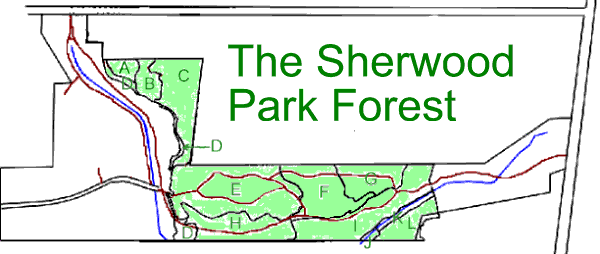
Sherwood Park has one of the finest stands of native trees in the city. Steep slopes are covered in locally rare old growth forest with magnificent trees more than 150 years old. This woodland has experienced severe stress from the constant pressure of urban use. Erosion on the steep slopes which undermines trees causing them to fall, compaction of the soil around tree root systems, destruction of tree seedlings and other plant species required for regeneration of a healthy woodland, are examples of the problems threatening Sherwood Park’s beauty. These problems result from heavy use especially bicycle riding and walking on the steep slopes and in the woods. Too many “informal” trails have been created by these users, leading to woodland damage.
The Sherwood Park Advisory Committee composed of representatives from local residents’ associations and other user groups, meets regularly to advise the City’s Parks and Recreation Department on the management of Sherwood Park. Several native tree and shrub plantings have been undertaken by the Advisory Committee, jointly with the Department of Parks and Recreation, in areas of the Park experiencing erosion or requiring rehabilitation. These plantings involved local schools and members of local residents’ associations. The Advisory Committee has developed an overall set of guidelines for the management of Sherwood Park and produces an annual workplan listing projects for joint action with Parks and Recreation. The guidelines and workplans are intended to help preserve and restore the natural environment so that Sherwood Park’s educational and recreational potentials are realized and maintained.
To reach the community objectives, The City of Toronto produced a “Ravine Working Plan” for Sherwood Park in 1989 and an “Ecological Land Classification Vegetation Inventory and Monitoring Plan” in 1998/99 (by William Draper Consulting). The “Ravine Working Plan” provides guidelines for Management and maintenance of the natural ravine system to maintain the natural system so there will be a healthy environment for public recreation. “The goal is to restore natural vegetation and maintain the ravine in its historic natural character while maintaining it as a usable public space.” Closing of some trails and some erosion control measures were also recommended. The following paraphrases the regeneration situation and recommendations: The present overstory is composed mostly of desirable native species; however, the regeneration lacks both quantity and quantity and has low species diversity. Prolific regeneration of non-native species such as Norway maple threatens the future of native species within the ravine. Planting of native species is required and Norway maple regeneration must be removed from much of the area. Species that are shade tolerant or moderately shade tolerant and grow well on sand loam sites are ideal for this ravine. Suitable species are Sugar Maple, Red Maple, Red Oak, White Oak, Basswood, American Beech, White Pine and Eastern Hemlock. Naturally occurring regeneration together with these plantings will help to maintain a healthy ecosystem for the future.
The table below gives some additional data on the forest type areas shown in the above map.
| AREA | TREE SPECIES | SOIL & | Lower Vegetation | Species | % Alien |
| & ABUNDANCE | MOISTURE | Total # | |||
| A | Chb42 Mn13 Or11 Pw9 Ashw6 Ashr6 Msug4 Mr4 Bw2 Hem2 Elmw2 | LmyFnSand Dry-fresh | GMustd, Chch, BlSwallow-wort, Witch Hazl, Oxalis | 100 | 50% |
| B | Pw35 Hem27 Msug21 Chb9 Beech6 Elmw3 | LmyFnSand Fresh-moist | Chch, Witch H, alDog, P.Ivy, GMustd, Mn&Msug regen | 31 | 26% |
| C | Beech31 Pw21 Hem16 Chb7 Msug7 Bw5 Mn5 Mr2 Ashw2 Mulb1 Mm1 | FSL + LFS Dry-fresh | Beech regen, Chch, WH, Mn&Msug regen, GM, VirCrp | 67 | 29% |
| D | Bw21 Chb18 Mm16 Mn11 Beech11 Mr7 Elmw5 Wilcr5 By2 Msug2 Pw2 | LmyFnSand Fresh-moist | Raspbry-r&b, Mm, Goldenrod, etc. | 125 | 41% |
| E | Or24 Mr23 Pw21 Chb8 Ashw6 Hem4 Msug4 Beech4 Ow3 Wlntb3 | LmyFnSand Dry-fresh | WH, Chch, Msug, Chb, Mn&Msug regen, Gm, MLVib | 130 | 36% |
| F | Msug46 Beech31 Or14 Mr7 Chb3 | LmyFnSand Dry-fresh | Chch, Msug, Fsolmnsl, zzGldnrd, | 72 | 31% |
| G | Msug60 Or30 Chb4 Beech2 Mr2 | LmyFnSand Dry-fresh | Chch, Msug, GM, Nightshade, zzGldnrd, | 57 | 39% |
| H | Or42 Beech22 Hem 15 Mr9 Ow3 Msug3 By1 Chb1 Pw1 | LmyFnSand Fresh-moist | Chch, Beech, WH, Chb, Ashr, Gm, Sensfern, tall wht lettuce | 85 | 27% |
| I | Msug41 Mr14 Beech12 Ashr8 Chb8 | Slm-Sclay Fresh-moist | alDog, Chch, Msug, Ashr, Goldnrd, Coltsfoot, | 115 | 27% |
| J | Mm Ashr | Clay loam Open bluff | hlWill, Goldnrd, JKW, Sumac, blBulrush, etc. | 79 | 39% |
| K | Mm Bass Msug | Clay loam Open bluff | Goldnrd, Raspbryr&b, JKW, alDog, hlWill, Nettle,Sowthsl,etc. | 74 | 41% |
| L | Msug Ash Or Hem Mm Mr Mn Bass Beech Ow Mm Will Walb Cot Elm | Clay loam Dry-fresh -moist | alDog, Msug, Chch, rlDog, GM, zzGoldnrd, etc. | 70 | 40% |
